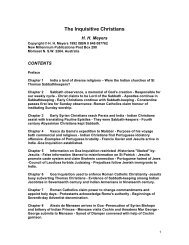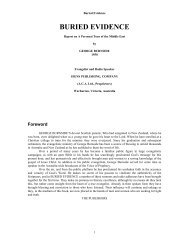Battle of the Bibles - Present Truth
Battle of the Bibles - Present Truth
Battle of the Bibles - Present Truth
You also want an ePaper? Increase the reach of your titles
YUMPU automatically turns print PDFs into web optimized ePapers that Google loves.
In 1583, while writing to a Jesuit, Dr Fulke mentioned that Bishop Lindanus had<br />
written a whole book on how he longed to have <strong>the</strong><br />
"errors, vices, corruptions, additions, detractions, mutilations, uncertainties,<br />
obscurities, pollutions, barbarisms and solecisms <strong>of</strong> <strong>the</strong> Vulgar Latin translation<br />
corrected and reformed".<br />
He also quoted a monk, Isidarius Clarius, as saying that <strong>the</strong> Catholic Latin<br />
Vulgate was:<br />
'full <strong>of</strong> errors, almost innumerable" (Fulke, "Defence <strong>of</strong> Translations <strong>of</strong> <strong>the</strong> Bible"<br />
(1583) p 62, cited in, "Our Authorised Bible Vindicated", p 49).<br />
It was from this Latin Vulgate that <strong>the</strong> Douay Bible was translated into English<br />
(1609) in order to counter <strong>the</strong> English Protestant <strong>Bibles</strong> flowing from Tyndale's<br />
translation which relied on <strong>the</strong> Greek Testament <strong>of</strong> Erasmus. These <strong>Bibles</strong> were<br />
branded and burned by Rome as, "Waldensian <strong>Bibles</strong>" because <strong>the</strong>y had a common<br />
pedigree. When in 1611 <strong>the</strong> King James Version appeared, it too had a pedigree similar<br />
to <strong>the</strong> "Waldensian <strong>Bibles</strong>" or <strong>the</strong> Itala, for <strong>the</strong>y are all <strong>of</strong> <strong>the</strong> traditional Received Text<br />
line.<br />
As <strong>the</strong> Rheims-Douay Bible (1582, 1609) was circulated in an attempt to<br />
counteract <strong>the</strong> "Waldensian <strong>Bibles</strong>", many differences were apparent. Yet, it did not<br />
contain <strong>the</strong> blatant discrepancies that would have existed had <strong>the</strong> Rheims Douay<br />
slavishly followed Constantine's Eusebius Bible.<br />
But this is exactly what happened when in 1881 Westcott and Hort reverted to<br />
<strong>the</strong> Greek Text <strong>of</strong> Eusebius by using <strong>the</strong> Vaticanus and Sinaiticus, for <strong>the</strong>se are<br />
considered to be two surviving Constantine <strong>Bibles</strong>.<br />
There is a second reason why <strong>the</strong> Douay Bible <strong>of</strong> today agrees more <strong>of</strong>ten with<br />
<strong>the</strong> KJ V than with many <strong>of</strong> <strong>the</strong> modern versions. Let <strong>the</strong> Roman Catholics explain why:<br />
"The version now in use has been so seriously altered that it can be scarcely<br />
considered identical with that which went by <strong>the</strong> name <strong>of</strong> <strong>the</strong> Douay Bible ... Although<br />
<strong>the</strong> <strong>Bibles</strong> in use at <strong>the</strong> present day by <strong>the</strong> Catholics <strong>of</strong> England and Ireland are<br />
popularly styled <strong>the</strong> Douay Version, <strong>the</strong>y are most improperly called; <strong>the</strong>y are founded<br />
with more or less alteration, on a series <strong>of</strong> revisions by Bishop Challoner in 1749-1752 ...<br />
The changes introduced by him are so considerable that, according to Cardinal<br />
Newman, <strong>the</strong>y almost amounted to a new translation. So, also, Cardinal Wiseman wrote,<br />
'to call it any longer <strong>the</strong> Douay or Rheimish Version is an abuse <strong>of</strong> terms. It has been<br />
altered and modified until scarcely any verse remains as it was originally published. In<br />
nearly every case, Challoner's changes took <strong>the</strong> form approximating to <strong>the</strong> Authorised<br />
Version "' ("The Catholic Encyclopedia", Article Douay Bible).<br />
Imitation is <strong>the</strong> sincerest form <strong>of</strong> flattery. Here we have an implied admission by<br />
Rome that her Latin Vulgate is inferior to <strong>the</strong> Received Text. So, in an attempt to gain<br />
credibility in <strong>the</strong> English-speaking world, she was willing to modify what she has<br />
consistently claimed to be <strong>the</strong> true text!<br />
We have noted <strong>the</strong> way in which revised versions have built on <strong>the</strong> doubts<br />
injected into <strong>the</strong> Revised Version by Westcott and Hort. Yet, amazingly, we later find <strong>the</strong><br />
Roman Catholic Jerusalem Bible <strong>of</strong>ten adopting <strong>the</strong> errors <strong>of</strong> <strong>the</strong> RV and RSV thus<br />
placing itself at variance with <strong>the</strong> Douay!<br />
To explain this, we must remember <strong>the</strong> crafty way in which <strong>the</strong> Roman Cardinals,<br />
Wiseman and Newman, brought about <strong>the</strong> so-called revision <strong>of</strong> <strong>the</strong> KJV. They let alleged<br />
Protestants do <strong>the</strong> odious work which <strong>the</strong>y <strong>the</strong>mselves, as open converts to Catholicism<br />
dare not undertake - namely, to insinuate <strong>the</strong> corrupt <strong>Bibles</strong> <strong>of</strong> Eusebius and Jerome into<br />
16





